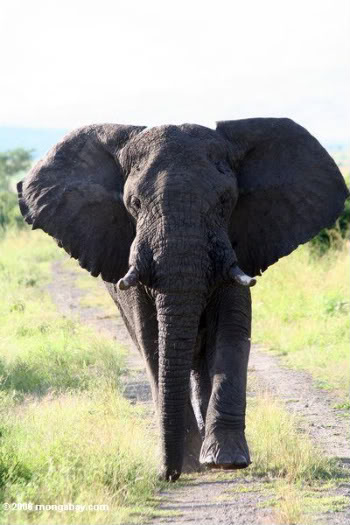Nearly twenty years ago the ivory trade was banned by Convention on International Trade in Endangered Species (CITES). Many saw this as the most important step in preventing the continued loss of elephants at the hands of poachers, and for awhile poaching slowed down. But now elephants are in danger again: a report by the International Fund for Wildlife Welfare (IFWW) states that an astounding 38,000 elephants are killed for their tusks annually—over a hundred every day.
If the number poached elephants were to remain steady, the illegal wildlife trade could potentially drive elephants in Africa to extinction by 2025. IFWW is calling for a total ban of all ivory sales. Since taking on the issue, CITES has allowed a few one off sales of ivory from elephants that died natural deaths.
 African elephant in Uganada, which has recently announced it will start big game hunting, though not including African elephants. Photo by: Rhett A. Butler. |
Some conservationists argue that a legitimate and legal ivory trade could benefit elephants. In other words, if countries with sizeable populations of elephants were allowed to sell the ivory from already deceased individuals they could use the profit for increased conservation efforts, including more anti-poaching patrols.
“The problem is that the possibility of these sales is revisited at every CITES conference, which means that legal buyers (currently, ivory traders and merchants in China and Japan) can never be certain of future supply. That keeps the black market alive, preventing legal ivory from undercutting illicit supplies and crippling organized poaching,” John Frederick Walker wrote in a Washington Post op-ed on the issue.
Others say that any ivory sold legally sends the wrong message and allows demand to remain high in China and Japan, providing poachers with the wealthy clientele they need to make elephant killing worthwhile.
“Most people will be shocked to hear that, 20 years on from a ban on international ivory trade, elephants in Africa are still threatened by commercial poaching. The ivory trade must be banned once again, and comprehensively, if we want to prevent the extinction of elephants,” Robbie Marshland director of IFAW UK told the Telegraph. “Sadly, the truth is that ivory trade anywhere is a threat to elephants everywhere.”
Related articles
Vanishing forest elephants are the Congo’s greatest cultivators

(04/09/2009) A new study finds that forest elephants may be responsible for planting more trees in the Congo than any other species or ghenus. Conducting a thorough survey of seed dispersal by forest elephants, Dr. Stephen Blake, formerly of the Wildlife Conservation Society (WCS) and now of the Mac Planck Institute for Ornithology, and his team found that forest elephants consume more than 96 species of plant seeds and can carry the seeds as far as 57 kilometers (35 miles) from their parent tree. Forest elephants are a subspecies of the more-widely known African elephant of the continent’s great savannas, differing in many ways from their savanna-relations, including in their diet.
Elephants populations in the Congo drop 80 percent in fifty years
(03/11/2009) According to the conservation organization Wildlife Direct , Wildlife Direct a recent survey of elephants in the Democratic Republic of Congo reveals that populations have dropped 80 percent in fifty years. The survey was conducted by John Hart using forest inventories, aerial surveys, and interview with local peoples.
Chad’s elephant population falls by two-thirds in two years
(12/11/2008) Civil strife of Chad — a consequence of the calamity in Darfur — is taking a toll on the country’s elephant population, reports the Wildlife Conservation Society (WCS) which has launched an emergency appeal for funds to support conservation efforts in the country.